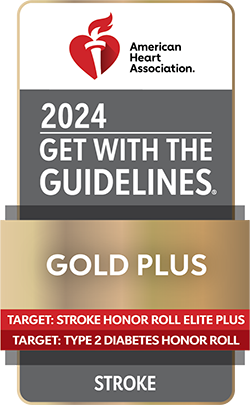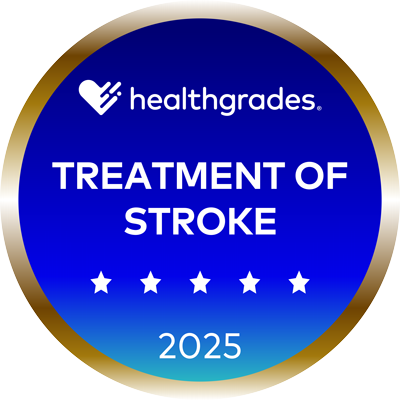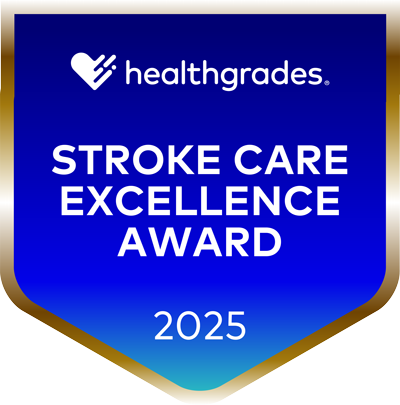Primary Stroke Center in Las Vegas
Stroke is a leading cause of death and is a major cause of serious disability. According to the Center for Disease Control & Prevention, more than 795,000 people in the U.S. have a stroke every year. MountainView Hospital offers comprehensive stroke services to aid in diagnosis, treatment, education and outreach.
Through our program, a trained team of doctors and nurses work to identify stroke symptoms as quickly as possible, beginning with emergency medical service workers in the field.
Our stroke center also increases education and awareness of stroke symptoms to both healthcare professionals and the community.
To learn more about our stroke care services, please call (702) 962-5021.
MountainView Hospital is recognized with the highest national standards for safety and quality care in the rapid response and treatment of acute stroke patients.
MountainView Hospital is certified as a Primary Stroke Center by The Joint Commission and is recognized by the American Heart Association/American Stroke Association for the following:
- Achieving 85 percent or higher compliance with all Get With The Guidelines® - Stroke Achievement Measures for two or more consecutive years
- Achieving 75 percent or higher compliance with five or more Get With The Guidelines® - Stroke Quality Measures for two or more consecutive years
- Achieving Time to Intravenous Thrombolytic Therapy less than or equal to 60 minutes in 50 percent or more of applicable acute ischemic stroke patients to improve quality of patient care and outcomes
Types of stroke we treat
A stroke is a medical emergency requiring fast treatment to restore proper blood flow and prevent damage to the brain. At MountainView, we offer treatment for two types of stroke:
Ischemic stroke—During an ischemic stroke, an artery that supplies blood to the brain is blocked, which deprives the brain of vital blood and oxygen.
Hemorrhagic stroke—During a hemorrhagic stroke, a weakened blood vessel or aneurysm causes bleeding in the brain, putting additional pressure on the brain and causing damage.
Stroke signs and symptoms
Stroke symptoms occur suddenly and differ depending on the part of the brain affected. Also, multiple symptoms can happen at the same time. Brain tissue dies quickly when deprived of oxygen, which is why it's important to get help immediately.
If you observe any of these stroke symptoms, call 911 right away:
- Sudden weakness or numbness of the face, arm, or leg, especially on one side of the body
- Sudden confusion
- Sudden trouble speaking or understanding
- Sudden trouble seeing in one or both eyes
- Sudden dizziness, trouble walking, loss of balance, or coordination
- Sudden severe headache with no known cause
Another way to observe stroke symptoms is to “B.E. F.A.S.T”:
- B – Balance Is the person suddenly having trouble with balance or coordination?
- E – Eyes, is the person experiencing suddenly blurred or double vision or a sudden loss of vision in one or both eyes?
- F — Face droops on one side when the person tries to smile
- A — Arm drifts down when the person raises both arms
- S — Speech is slurred or strange when saying a simple phrase
- T — Time to call 911 if you observe any of these symptoms
Stroke treatment
Proper medical evaluation and prompt treatment are vital to recovering from a stroke. Treatment varies, as it depends on the type of stroke. The primary goal in treating an ischemic stroke is to open up the blockage. In a hemorrhagic stroke, the aim is to relieve the excess pressure being put on the brain by the artery's bleeding or an aneurysm.
Stroke treatments may include:
- Antiplatelet and anticoagulants — Antiplatelet medications prevent blood clots by making it more difficult for the blood’s platelets to stick together. Anticoagulants reduce the blood’s ability to clot.
- Clot-breaking medications — These medications can break up blood clots in the brain’s arteries, stop the stroke and reduce damage to the brain.
- Mechanical thrombectomy — During this procedure, a catheter directly delivers a clot-disrupting or retrieval device to pull the clot out of the vessel.
- Stents — This procedure treats artery walls that have weakened by inflating the narrowed artery and supports the artery walls with a stent.
- Surgery — If other treatments do not work, surgery to remove a blood clot and plaques from arteries may be performed.
Stroke risk factors
There are certain risk factors that can place you at a higher risk of experiencing a stroke, such as:
- Increasing age
- Family history of stroke
- High blood pressure
- Smoking
- Obesity
Stroke prevention
Prevention is possible, whether you’re preventing a first stroke or trying to prevent a second. To help reduce your chance of experiencing a stroke, take the following steps:
- Check blood pressure frequently and follow your doctor's recommendations for keeping it in a safe range
- Drink alcohol only in moderation (one to two drinks per week)
- Eat more fruits and vegetables and limit dietary salt and fat
- Exercise regularly
- Increase your consumption of fish
- Keep chronic medical conditions under control, including high cholesterol and diabetes
- Maintain a healthy weight
- Seek medical care if you have symptoms of a stroke, even if symptoms stop
- Stop smoking
- Stop the use of recreational drugs (cocaine, heroin, marijuana, amphetamines)
- Address any heart problems
Stroke support group
After a stroke, patients can experience various emotional and physical challenges, including anger, anxiety, depression, difficulty eating or swallowing, confusion, trouble walking, or vision. That's why it's essential to connect with other stroke survivors and their caregivers or families for support.
The MountainView stroke support group's goal is to help patients, caregivers and families share experiences related to stroke and learn about the rehabilitation and recovery process and life after stroke. Additionally, this free service allows patients to discuss various insights on living after stroke and creating a stroke care plan.
Location and time
The stroke group meets the first Tuesday of each month from 2pm to 3pm. Meetings are located at:
MountainView Hospital Medical Office Building
3150 North Tenaya Way, Suite 114
Las Vegas, NV 89128
Registration is required. To register for the support group or to get more information, call (702) 962-5021.



